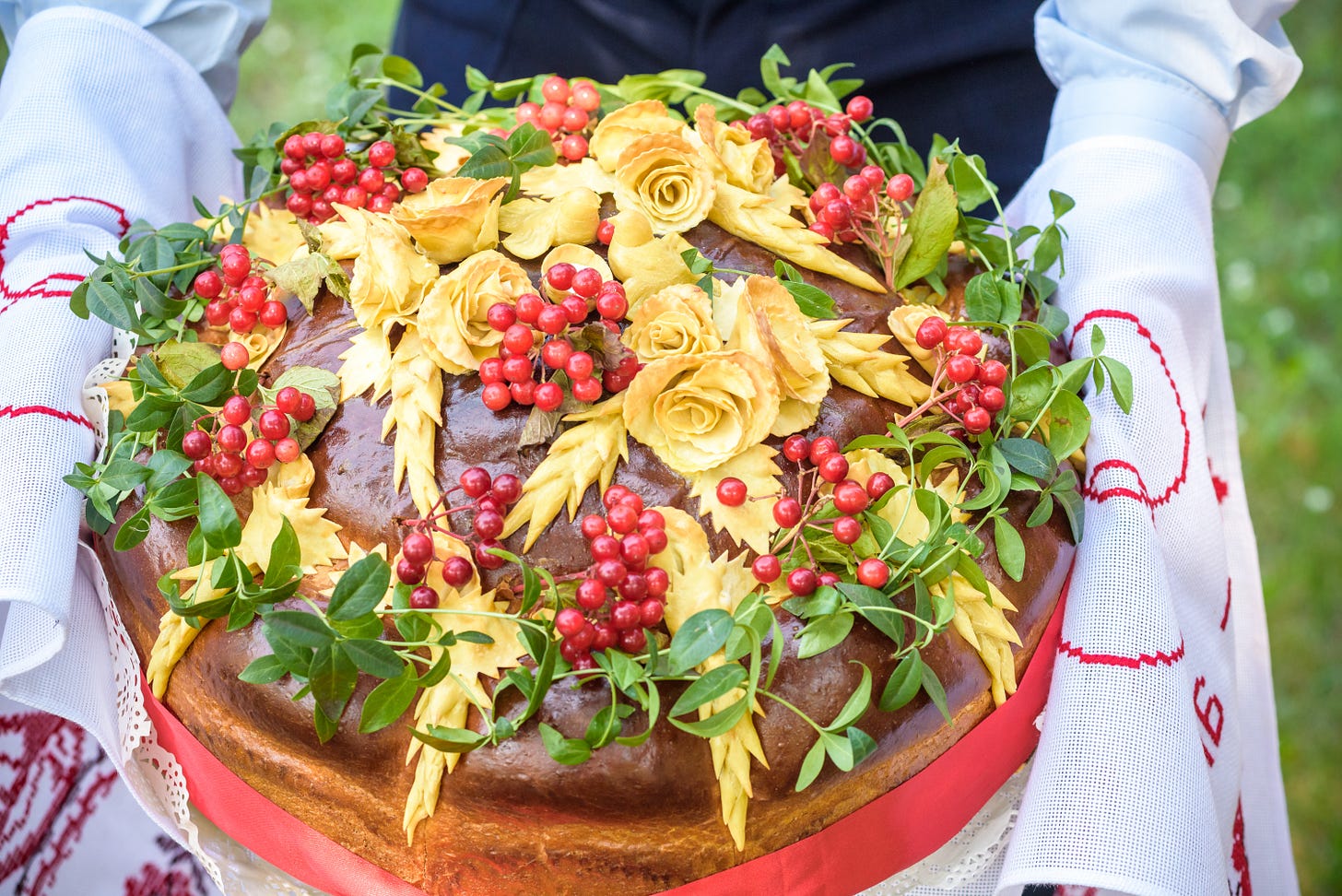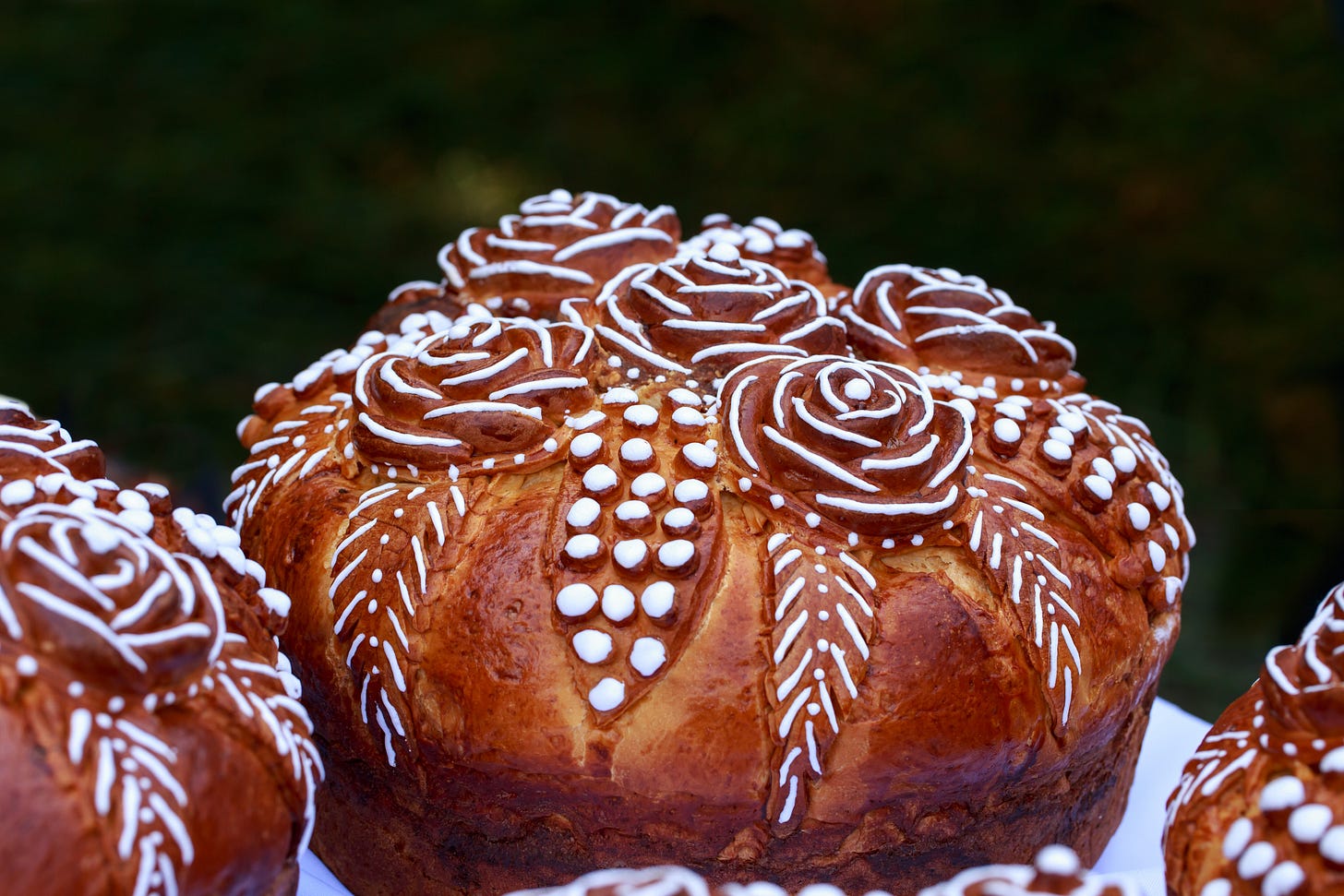I have launched a restaurant review site called How to Eat L.A. If you like anything about that, please go check it out! -Katherine
If you haven’t become a paid Smart Mouth subscriber yet, please consider it. The money goes straight to paying freelancers a good rate - much better than most publications. And if not that, click on the heart icon above so I know you’re reading! Please enjoy the article below by Tasha Lowe-Newsome.
The Art of Ukrainian Wedding Bread
By Tasha Lowe-Newsome
Wedding bread is common to Slavic countries, but it is an art form in Ukraine, where it is recorded as far back as the eleventh century.
Traditional korovai has stringent baking requirements. The dough must be mixed, kneaded, and decorated by seven happily married women with children. Widows or divorcees need not apply. Ideally, they wear traditionally embroidered vyshyvanka (shirts) and their red wedding belts. They begin work with a prayer. Often, a priest blesses the loaves before a happily (happily!) married man puts them into the oven.
The bread, a variation on brioche, typically includes evaporated milk, sugar, wheat flour, butter, eggs, vanilla … and holy water. Regional and family variations abound, but all are packed with yeast, for folklore holds the higher the bread the better the marriage. Fallen or cracked loaves are ill omens.
The loaves are decorated with symbols deeply rooted in Ukrainian culture. Birds represent the couple (bride with furled wings, groom’s wings outstretched), flowers for beauty, wheat for prosperity, pinecones for fertility, grapes for wealth, braids for the entwining of the couple’s families. A wreath of periwinkle for fidelity and eternal love is often wrapped around the base. The decorations are made with “dead” or yeast-less dough.
Greeting Bread, a single, undecorated loaf, with space for a small bowl of salt at the top, is baked along with the korovai. The newlyweds are met at the reception by their parents with the greeting bread. The couple eats a piece of the bread dipped in salt as recognition of hardships that will inevitably come. A second piece is washed down with wine to denote the celebrations that are also ahead. This is an occasion for the machatunim (in-laws) to impart their wisdom for negotiating married life.
During the wedding ceremony, the korovai is placed on the altar or held by a trusted elder. At the reception the korovai is the centerpiece. Once the festivities conclude the korovai is shared with guests and musicians. The couple pulls off the first pieces. Superstition says the person with the larger piece will “rule the house.”
These days it is hard to find seven happily married women with the time or skills to bake bread. Modern korovai are baked in specialty bakeries, like Kyivkhlib, Ukraine’s largest producer of sweet bread. In another modern twist, Nazarii and Mariya Napora, a married couple, bake korovai professionally in Lviv.
The historic ideal holds that a couple’s korovai is a once in a lifetime treat, but now national pride encourages the celebration of birthdays, anniversaries, and graduations with scaled-down versions of decorated breads. A piece for everyone, all the time.
Episode 217: Pumpkin Pie with Rossi Anastopoulo
Is it Thanksgiving if there's no pumpkin pie?
Listen to Smart Mouth: iTunes • Google Podcasts • Stitcher • Spotify • RadioPublic • TuneIn • Libsyn
If you liked the newsletter today, please forward it to someone who’d enjoy it, and tap the heart icon above or below, which will help me reach more readers. I appreciate your help, y’all!
This newsletter is edited by Katherine Spiers, host of the podcast Smart Mouth.
A TableCakes Production.
Want to contribute? Here are the submission guidelines.








